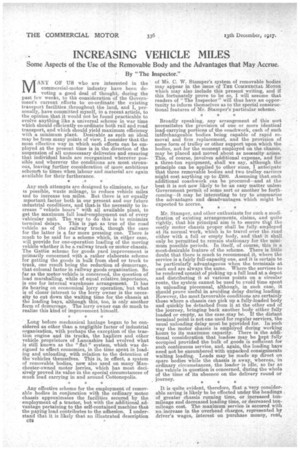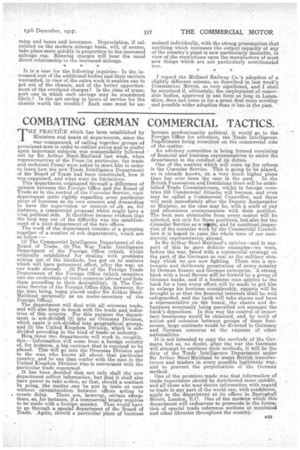INCREASING VEHICLE MILES
Page 4

Page 5

If you've noticed an error in this article please click here to report it so we can fix it.
Some Aspects of the Use of the Removable Body and the Advantages that May Accrue.
By "The Inspector."
MANY OF ITS who are interested in the commercial-motor industry have been devoting a good deal of thought, during the past few weeks, to the consideration of the Government's current efforts to co-ordinate the existing transport facilities throughout the land, and I, personally, have committed myself, in a recent article, to the opinion that it would not be found practicable to evolve anything like a universal scheme in war time which should efficiently co-ordinate both rail and road transport„ and which, should yield maximum efficiency with a minimum plant. Desirable as such an ideal may be from many points of view, I consider that. the most effective way in which such efforts can be employed at the present time is in the direction of the suspension of all unnecessary deliveries and ensuring that individual hauls are reorganized wherever possible and wherever the conditions are most strenuous, leaving further consideration of more ambitious scheme's to times when labour and material are again available for their furtherance.
Any such attempts are designed to eliminate, so far as possible, waste mileage, to reduce vehicle miles knd to increase ton miles. But there is air equally mportant factor both in our present and our future industrial conditions, and thatc is the necessity to increase "vehicle hours" with all available plant, to get the maximum full loadsernployment out of every vehicular unit. The wax to do this is to minimize terminal delays. This is just as true of the road vehicle as of the railway truck, though the case for the latter is a far more pressing one. There is much to be said for a scheme which, in either case, will provide for one-operation loading of the moving vehicle whether it be a railway truck or motor chassis. The Gattie scheme for goods yard improvement is primarily concerned with a rather elaborate scheme for getting the goods in bulk from shed or truck to truck, one result being the reduction ofdemurrage, that colossal factor in railway goods organization. So far as the motor' vehicle is concerned, the question of load marshalling, while of equal relative importance, is one for internal warehouse arrangement. It has its bearing on economical lorry operation; but what is of closer interest to' the lorry owner is the necessity to cut down the waiting time for the chassis at the loading bays, although this, too, is only another form of demurrage. The lorry owner can do much to realize this kind of improvement himself.
Long before mechanical haulage began to be considered as other than a negligible factor of industrial organization, with perhaps the exception of the traction engine and its trucks, the hapliers and other • vehicle proprietors of Lancashire had evolved what is still known as the " flat " system, which was de • signed to effect economies, in the time spent in loading and unloading, with relation to the detention of the vehiclesthemselves. This is, in effect, a system of removable bodies, now also used on many Manchester-owned motor lorries, which has most deci . fuvely proved its value in the special circumstances of much load carrying in and around Gottonopolis.
• Any effective scheme for the employment of removable bodies in conjitnetion with the ordinary motor chassis approximates the facilities secured by the employment of a tractor, but with the additional advantage pertaining to the self-contained machine that the paying load contributes to the adhesion. I understand that it is likely that an illustrated description of Mr. P. W. Stamper's system of removable bodies may appear in the issue cif THE COMMERCIAL MOTOR which may also include this present writing, and if this fortunately prove to be so I will assume that readers of " The Inspector" will thus have an opportunity to inform themselves as to the special constructional features of Mr. Stamper's particular scheme.
Broadly speaking, any arrangement of this sort necessitates the provision of one or more identical load-carrying portions of the coachwork, each of such intgrchangeable bodies being capable of rapid removal and firm replacement, and the provision of some form of trolley or other support upon which the bodies, not for the moment employed on the chassis, may be placed and moved about as necessity. arises. This, of course, involves additional expense, and for a. three-ton equipment, shall we say, although the principle can be applied to other sizes, I anticipate that three removable bodies and two trolley carriers might cost anything up to 2200. Assuming that, such additional coachwork can be procured—and at the best it is not now likely to be an easy matter unless Government permit of some sort or another be forthcoming—it may be interesting to try to summarize the advantages and disadvantagea which might. be expected to accrue.
Mr. Stamper, and other enthusiasts for such a modification of existing arrangements, claims, and quite rightly, that his principal aim is to ensure that the costly motor chassis proper shall be fully employed at its normal work, which is to travel over the road either with a full or empty body, and that it shall only be permitted to remain stationary for the minimum possible periods. In itself, of course, this is a most-desirable feature of the scheme. There is little doubt that there is much to recommend it, where the service is a fairly full-capacity one, and it is certain to be particularly advantageous when the terminals at eachend are always the same. Where the services to be rendered consist of picking up a full load at a depot and distributing it at various points on a circular route, the system cannot be used to avoid time spent in unloading piecemeal, although, in such case, it should prove useful in avoiding delay during loading. However, the most favourable conditions are certainly those where a chassis can pick up a fully-loaded body and .quickly, be detached from it at the other end of the Journey, bringing back another body either fully loaded or empty, as the case May be. If the distant terminal point is not one used for regular services, the usual unloading delay must be provided for. In such way the motor chassis is employed during working hours to its maximum capacity. There is the additional consideration that loadeas may be kept fully occupied provided the bulk of goods Is sucaent for such continuous service, and, again, the loading bays need not be encumbered with unpacked consignments waiting loading. Loads may be made up direct on spare bodies While the chassis is away, whereas, in ordinary circumstances, the loader is idle, so far as the vehicle in question is concerned, during the whole of the time of its absence on the delivery round or journey.
It is quite evident, therefore, that a very considerable saving is likely to be effected under the headings of greater chassis running time, or increased tonmileage and decreased loading time, or decreased tonmileage cost. The maximum service is secured with no .increase in the overhead charges, represented by driver's wages, interest on purchase money, rent, rates and taxes and insurance. Depreciation, if calculated on the modern mileage basis, will, of course, take place more quickly in proportion to the increased mileage run. Running charges will bear the usual direct relationship to the increased mileage.
It is a case for the following inquiries : Is the increased cost of the additional bodies and their carriers warranted, in view of the extra work it enables one to get out of the chassis, and of the better apportionment of the overhead charges ? Is the class of transport one in which such savings may be considered likely ? is the net saving in hours of service for the chassis worth the trouble? Each case must be ex
amined individually, with the strong presumption that anything which increases the output capacity of any of the country's pla,nt is now particularly desirable, in view of the restrictions upon the manufacture of most new things which are not particularly munitionsSof war.
I regard the Midland Railway Co.'s adoption of a slightly different scheme, as described in last week's COMMiRCIAL MOTOR, as very significant, and I shall be surprised if, ultimately, the employment of removable bodies, approved in one form so long in Lancashire, does net come in for a great deal more scrutiny and possible wider adoption than it has in the past.


























